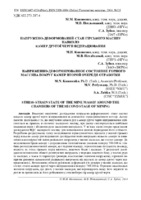Будь ласка, використовуйте цей ідентифікатор, щоб цитувати або посилатися на цей матеріал:
http://ir.nmu.org.ua/handle/123456789/153913Повний запис метаданих
| Поле DC | Значення | Мова |
|---|---|---|
| dc.contributor.author | Kononenko, M. N. | - |
| dc.contributor.author | Petlyovany, M. V. | - |
| dc.contributor.author | Zubko, S. A. | - |
| dc.date.accessioned | 2019-03-29T14:31:57Z | - |
| dc.date.available | 2019-03-29T14:31:57Z | - |
| dc.date.issued | 2014 | - |
| dc.identifier.uri | http://ir.nmu.org.ua/handle/123456789/153913 | - |
| dc.description.abstract | A stress-strain state of the rock mass around the chambers of the second stage of mining was analyzed with the help of thermodynamic method. This study is the question of the day as the ore reserves in the chambers of the second stage of mining are, as a rule, extracted being surrounded by the filling mass, and due to this the highest rates of the ore losses and contamination with the filling mass are observed. In connection with this, the study of the stress-strained state of the filling mass and establishment of a method for improving the massif stability presents a great interest today. A calculation scheme for modeling thermodynamic processes in the rock mass around the chambers was developed with the purpose to study the stress field and determine principles of radial stress changing in the filling mass of the surrounding chamber. A chamber in the layer at the depth of 740-840 m was simulated with the following average geotechnical conditions: depth of the extraction chamber, angle of the deposit depression, horizontal thickness of deposit, rock strength in the hanging layer against uniaxial compression, rock strength in the bottom layer against uniaxial compression, and stowing strength against uniaxial compression. The study determined areas with tensile stress in the rocks of the bottom layer, ore mass and filling mass, and their parameters (size, maximum tension) and formulated empirical equations for the dependences between radial tensions and distance to the chambers L of the second stage of mining. The areas of destructive deformation and their dimensions in the stowing mass around the chambers of the second stage of mining at the level 740-840 m were established. Maximum values are defined for the stresses acting in the stowing mass which, exceeding the ultimate strength, cause the mass failure into the space of the chamber of the second stage. In order to prevent the stowing mass failure it is recommended to make a consolidating layer of the solid stowing at the 2/3 height of the chamber in order to resist the high tensile stresses and to ensure the mass stability. | ru_RU |
| dc.language.iso | uk | ru_RU |
| dc.publisher | Geotechnical mechanics | ru_RU |
| dc.subject | unload area | ru_RU |
| dc.subject | radial stress | ru_RU |
| dc.subject | stowing mass | ru_RU |
| dc.subject | strength of the solid stowing | ru_RU |
| dc.title | Stress-strain state of the mine massif around the chambers of the second stage of mining | ru_RU |
| dc.type | Article | ru_RU |
| dc.identifier.udk | 622.273.217.4 | ru_RU |
| Розташовується у зібраннях: | Кафедра гірничої інженерії та освіти | |
Файли цього матеріалу:
| Файл | Опис | Розмір | Формат | |
|---|---|---|---|---|
| Kononenko_Petlyovany_Zubko_2014_GM_115_120-130.pdf | 583,28 kB | Adobe PDF |  Переглянути/Відкрити |
Усі матеріали в архіві електронних ресурсів захищені авторським правом, всі права збережені.
